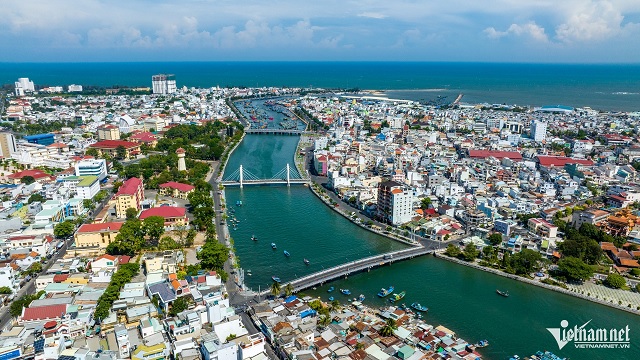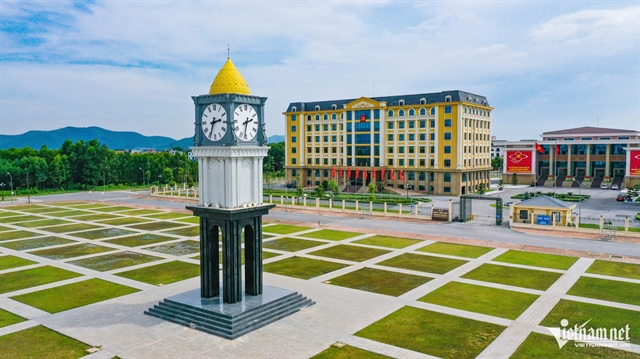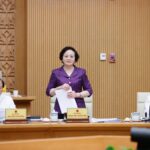The Ministry of Home Affairs has submitted a proposal to the government regarding the reorganization of provincial-level administrative units in 2025. This proposal comes after the evaluation of 23 project proposals from 23 provinces and centrally-run cities, which have been selected to host the political and administrative centers of the new provincial-level administrative units.
Specifically, the reorganization will involve 52 administrative units across provinces and cities, including 4 cities: Hai Phong, Ho Chi Minh City, Da Nang, and Can Tho; and 48 provinces: Ha Nam, Hung Yen, Vinh Phuc, Bac Ninh, Thai Binh, Hai Duong, Nam Dinh, Ninh Binh, Bac Kan, Thai Nguyen, Phu Tho, Bac Giang, Hoa Binh, Tuyen Quang, Lao Cai, Yen Bai, Ha Giang, Ninh Thuan, Quang Tri, Phu Yen, Quang Binh, Quang Ngai, Khanh Hoa, Dak Nong, Tay Ninh, Binh Duong, Binh Thuan, Binh Phuoc, Ba Ria-Vung Tau, Ben Tre, Bac Lieu, Vinh Long, Hau Giang, Tra Vinh, Tien Giang, Soc Trang, Dong Thap, An Giang, Long An, Ca Mau, Quang Nam, Binh Dinh, Dak Lak, Dong Nai, Gia Lai, Kon Tum, Lam Dong, and Kien Giang.
11 administrative units at the provincial level will not undergo reorganization, including 10 units that meet the prescribed standards: Hanoi, Hue, Lai Chau, Dien Bien, Son La, Lang Son, Quang Ninh, Thanh Hoa, Nghe An, and Ha Tinh; and one unit that does not meet the standards but has unique characteristics, Cao Bang.

Phan Thiet City, Binh Thuan Province. Photo: Hoang Ha
|
There are 23 plans for the reorganization of the 52 administrative units to form 23 new provincial-level units. Specifically:
1. Merge Ha Giang and Tuyen Quang provinces to form a new province named Tuyen Quang, with a natural area of 13,795.5 km2 and a population of 1,865,270 people. The political and administrative center will be located in the current Tuyen Quang Province.
2. Merge Yen Bai and Lao Cai provinces to form a new province named Lao Cai, with a natural area of 13,256.92 km2 and a population of 1,778,785 people. The political and administrative center will be located in the current Yen Bai Province.
3. Merge Bac Kan and Thai Nguyen provinces to form a new province named Thai Nguyen, with a natural area of 8,375.21 km2 and a population of 1,799,489 people. The political and administrative center will be located in the current Thai Nguyen Province.
4. Merge Vinh Phuc, Hoa Binh, and Phu Tho provinces to form a new province named Phu Tho, with a natural area of 9,361.38 km2 and a population of 4,022,638 people. The political and administrative center will be located in the current Phu Tho Province.
5. Merge Bac Giang and Bac Ninh provinces to form a new province named Bac Ninh, with a natural area of 4,718.6 km2 and a population of 3,619,433 people. The political and administrative center will be located in the current Bac Giang Province.
6. Merge Thai Binh and Hung Yen provinces to form a new province named Hung Yen, with a natural area of 2,514.81 km2 and a population of 3,567,943 people. The political and administrative center will be located in the current Hung Yen Province.
7. Merge Hai Duong and Hai Phong cities to form a new city named Hai Phong, with a natural area of 3,194.72 km2 and a population of 4,664,124 people. The political and administrative center will be located in the current Hai Phong City.
8. Merge Ha Nam, Ninh Binh, and Nam Dinh provinces to form a new province named Ninh Binh, with a natural area of 3,942.62 km2 and a population of 4,412,264 people. The political and administrative center will be located in the current Ninh Binh Province.
9. Merge Quang Binh and Quang Tri provinces to form a new province named Quang Tri, with a natural area of 12,700 km2 and a population of 1,870,845 people. The political and administrative center will be located in the current Quang Binh Province.
10. Merge Quang Nam and Da Nang cities to form a new city named Da Nang, with a natural area of 11,859.59 km2 and a population of 3,065,628 people. The political and administrative center will be located in the current Da Nang City.
11. Merge Kon Tum and Quang Ngai provinces to form a new province named Quang Ngai, with a natural area of 14,832.55 km2 and a population of 2,161,755 people. The political and administrative center will be located in the current Quang Ngai Province.
12. Merge Gia Lai and Binh Dinh provinces to form a new province named Gia Lai, with a natural area of 21,576.53 km2 and a population of 3,583,693 people. The political and administrative center will be located in the current Binh Dinh Province.
13. Merge Ninh Thuan and Khanh Hoa provinces to form a new province named Khanh Hoa, with a natural area of 8,555.86 km2 and a population of 2,243,554 people. The political and administrative center will be located in the current Khanh Hoa Province.
14. Merge Lam Dong, Dak Nong, and Binh Thuan provinces to form a new province named Lam Dong, with a natural area of 24,233.07 km2 and a population of 3,872,999 people. The political and administrative center will be located in the current Lam Dong Province.
15. Merge Dak Lak and Phu Yen provinces to form a new province named Dak Lak, with a natural area of 18,096.4 km2 and a population of 3,346,853 people. The political and administrative center will be located in the current Dak Lak Province.
16. Merge Ba Ria-Vung Tau, Binh Duong, and Ho Chi Minh City to form a new city named Ho Chi Minh City, with a natural area of 6,772.59 km2 and a population of 14,002,598 people. The political and administrative center will be located in the current Ho Chi Minh City.
17. Merge Dong Nai and Binh Phuoc provinces to form a new province named Dong Nai, with a natural area of 12,737.18 km2 and a population of 4,491,408 people. The political and administrative center will be located in the current Dong Nai Province.
18. Merge Tay Ninh and Long An provinces to form a new province named Tay Ninh, with a natural area of 8,536.44 km2 and a population of 3,254,170 people. The political and administrative center will be located in the current Long An Province.
19. Merge Can Tho City, Soc Trang, and Hau Giang provinces to form a new city named Can Tho, with a natural area of 6,360.83 km2 and a population of 4,199,824 people. The political and administrative center will be located in the current Can Tho City.
20. Merge Ben Tre, Vinh Long, and Tra Vinh provinces to form a new province named Vinh Long, with a natural area of 6,296.2 km2 and a population of 4,257,581 people. The political and administrative center will be located in the current Vinh Long Province.
21. Merge Tien Giang and Dong Thap provinces to form a new province named Dong Thap, with a natural area of 5,938.64 km2 and a population of 4,370,046 people. The political and administrative center will be located in the current Tien Giang Province.
22. Merge Bac Lieu and Ca Mau provinces to form a new province named Ca Mau, with a natural area of 7,942.39 km2 and a population of 2,606,672 people. The political and administrative center will be located in the current Ca Mau Province.
23. Merge An Giang and Kien Giang provinces to form a new province named An Giang, with a natural area of 9,888.91 km2 and a population of 4,952,238 people. The political and administrative center will be located in the current Kien Giang Province.
All 23 provinces and cities mentioned above meet the prescribed standards for provincial-level administrative units.
As a result of this reorganization, the country will have 34 administrative units at the provincial level, including 6 centrally-run cities (Hanoi, Hai Phong, Hue, Da Nang, Can Tho, and Ho Chi Minh City) and 28 provinces (Lai Chau, Dien Bien, Son La, Lang Son, Cao Bang, Tuyen Quang, Lao Cai, Thai Nguyen, Phu Tho, Bac Ninh, Hung Yen, Ninh Binh, Quang Ninh, Thanh Hoa, Nghe An, Ha Tinh, Quang Tri, Quang Ngai, Gia Lai, Khanh Hoa, Lam Dong, Dak Lak, Dong Nai, Tay Ninh, Vinh Long, Dong Thap, Ca Mau, and An Giang).

Bac Giang Province. Photo: Hoang Ha |
Continuing to use 33,956, with a surplus of 4,226 offices
Prior to submitting the proposal to the Ministry of Home Affairs, the People’s Committees of the provinces and cities organized consultations with the people and obtained approval from the provincial People’s Councils in accordance with regulations. The results of the consultations showed a high level of agreement, with an average approval rate of 96.19% nationwide, and all 52 provincial, district, and communal People’s Councils of the provinces and cities involved in the reorganization voted in favor of the proposal.
Regarding the plan for the reorganization and streamlining of the organizational apparatus, the provincial People’s Councils of the newly formed provinces will establish 3 committees: the Committee for Legal Affairs, the Committee for Economic and Budgetary Affairs, and the Committee for Cultural and Social Affairs. In provinces with a significant ethnic minority population, an additional Committee for Ethnic Affairs may be established.
The People’s Councils of centrally-run cities will establish 4 committees: the Committee for Legal Affairs, the Committee for Economic and Budgetary Affairs, the Committee for Cultural and Social Affairs, and the Committee for Urban Affairs.
For departments and equivalent agencies, those with similar functions and tasks will be merged. For some specialized agencies under the provincial People’s Committees that are unique to each province or city involved in the reorganization, the organizational structure, functions, tasks, and personnel allocation will remain largely unchanged.
After the reorganization, the provincial People’s Committees will have a maximum of 14 departments and equivalent agencies. Ho Chi Minh City will have a maximum of 15 departments and equivalent agencies.
Public health and education institutions at the provincial level will be maintained. For other public institutions directly under the provincial People’s Committees and under the departments and agencies, the guidance of authorized agencies will be followed.
The total personnel allocation for the 52 provinces and cities involved in the reorganization is 937,935 people (including 37,447 officials, 130,705 civil servants, and 769,783 public employees).
After the reorganization, the number of officials, civil servants, and public employees at the provincial level will not exceed the total number before the reorganization. Within 5 years, there will be a personnel streamlining process to improve the quality of the team.
According to the data provided in the proposals of the provinces and cities, the total number of provincial-level public offices in the 52 provinces and cities involved in the reorganization is 38,182. The number of public offices expected to continue in use is 33,956, and the number of surplus offices is 4,226.
Nguyen Thao
– 17:48 05/09/2025
The Magic Number: Why 60 is the Perfect Headcount for Each Administrative Unit
“In a recent development, Minister of Home Affairs Pham Thi Thanh Tra announced the completion of the overall plan for the rearrangement of administrative units at the provincial and communal levels. This plan is now ready to be presented to the National Assembly for their consideration. As per the proposed rearrangement, it is anticipated that each ward, commune, and special district will have an average temporary staffing allocation of 60 individuals.”
The Art of Provincial Mergers: Streamlining Administrative Boundaries
The government has instructed the Ministry of Home Affairs to take the lead in collaborating with relevant agencies and local authorities to promptly develop a proposal for the continued reorganization and streamlining of administrative units at the provincial, district, and communal levels. This initiative aims to enhance efficiency and effectiveness in governance. The proposal will be submitted to the Party Committee of the Government, ensuring both quality and timely implementation.




















